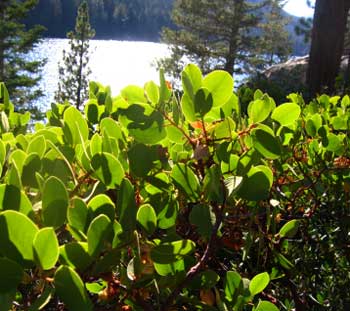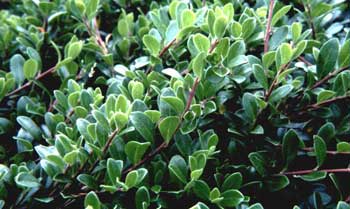Contents:
Common Names | Parts Usually Used | Plant(s) & Culture | Where Found | Medicinal Properties
Legends, Myths and Stories | Uses | Bibliography
Scientific Names

- Arctostaphylos patula L.
- Arctostaphylos mewukka L.
- Ericaceae
- Heath family
Common Names
Arctostaphylos patula L.
- Common manzanita
- Green leaf manzanita
Arctostaphylos mewukka L.
- Grey leaf manzanita
- Indian manzanita
Parts Usually Used
Fruits, leaves
Back to Top

Description of Plant(s) and Culture
Both green leaf and grey leaf manzanita are large, distinctive, evergreen shrubs; large crooked-branched from 3 to 6 feet high with smooth, red wood which is frequently used for dry decorations. The leaves are approximately 2 inches long, oval shaped, and leathery. With drooping panicles of attractive, small, urn-shaped pink or white flowers, followed by round berries in shades of red or pink. Tolerates poor soil but must have good drainage. Do not tolerate lime in the soil but once established care is minimal and rarely needs watering in summer.
Another variety: Bearberry (Arctostaphylos uva-ursi L.) or kinnikinnick as the Native Americans call it, is a third member of the heath family of manzanitas. It is a trailing evergreen that reaches a height of 6 inches and spreads to 15 feet or so. Reddish branches contrast with small bright-green leaves that turn bronze in the fall.
Back to Top
Where Found
Grow wild from northern California to Alaska; native to the west and northwest; Arizona, New Mexico.
Back to Top
Medicinal Properties
Fruits and leaves are astringent
Back to Top
Legends, Myths and Stories
Manzanita has been used in Europe and America as early as the 13th century. Leaves are harvested in late summer. Native Americans used the plant for food, leaves were for smoking, berries were eaten raw or ground into a meal for porridge. Cider and jelly were made from the berries.
Used as a tobacco substitute or additive.
Back to Top
Uses
A strong decoction of Manzanita leaves, applied warm externally, used to treat poison ivy and oak, rashes, and shingles. Berries and leaves are used to relieve bronchitis, kidney ailments, dropsy, and female disorders.
Back to Top
Bibliography
![]() The Herb Book
The Herb Book, by John Lust, Bantam Books, 666 Fifth Avenue, New York, NY. copyright 1974.
![]() Indian Herbalogy of North America
Indian Herbalogy of North America, by Alma R. Hutchens, Shambala Publications, Inc., Horticultural Hall, 300 Massachusetts Avenue, Boston, Massachusetts 02115, 1973
![]() Planetary Herbology
Planetary Herbology, by Michael Tierra, C.A., N.D., O.M.D., Lotus Press, PO Box 325, Twin Lakes. WI 53181., Copyright 1988, published 1992
![]() Webster’s New World Dictionary
Webster’s New World Dictionary, Third College Edition, Victoria Neufeldt, Editor in Chief, New World Dictionaries: A Division of Simon & Schuster, Inc., 15 Columbus Circle, New York, NY 10023
 The Rodale Herb Book: How to Use, Grow, and Buy Nature’s Miracle Plants (An Organic gardening and farming book)
The Rodale Herb Book: How to Use, Grow, and Buy Nature’s Miracle Plants (An Organic gardening and farming book), edited by William H. Hylton, Rodale Press, Inc. Emmaus, PA, 18049., 1974
